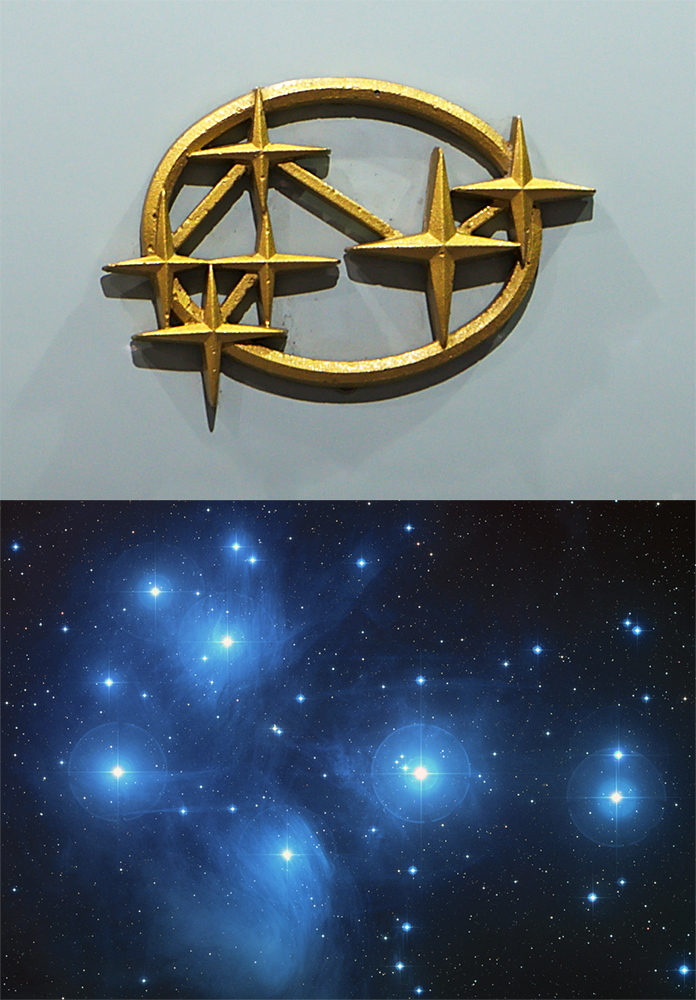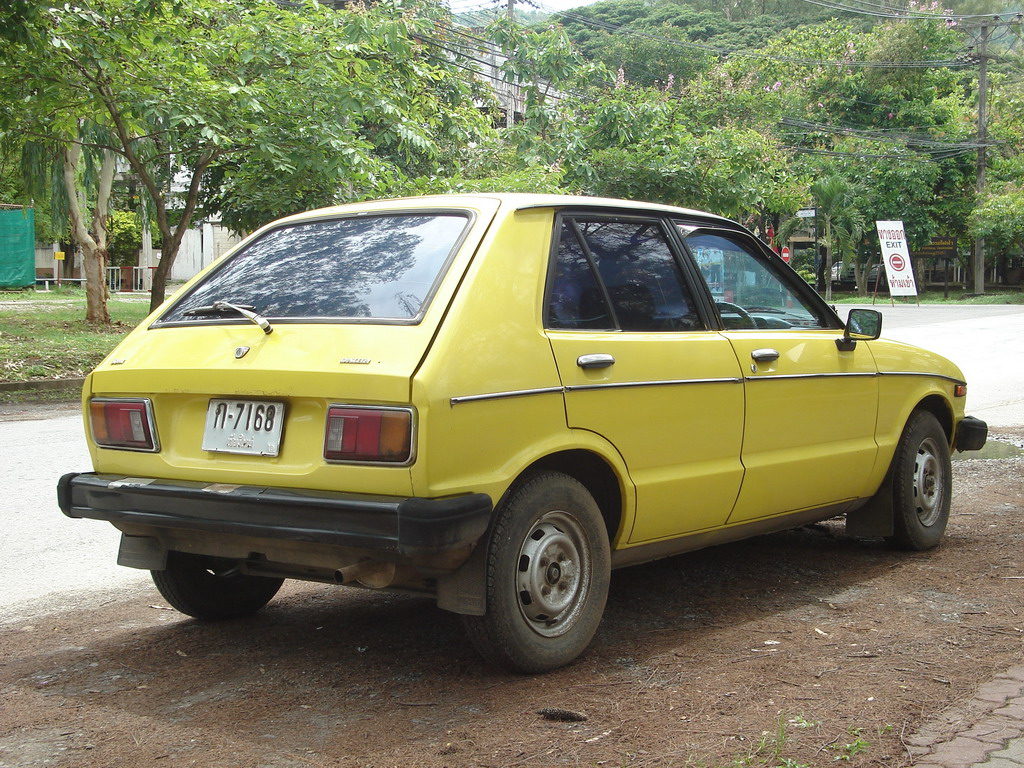|
Subaru Justy
The Subaru Justy is a subcompact hatchback that has been sold by Japanese automobile manufacturer Subaru since 1984. Subaru manufactured the Justy from 1984 to 1994; since then it has sold rebadged versions of other vehicles under the Justy nameplate. The company introduced the latest iteration, a rebadged Daihatsu Boon (second generation), at the 2007 Frankfurt Motor Show with a 1.0 or 1.2-liter straight-three engine, front/four wheel drive, electronically controlled continuously variable transaxle, or a 5-speed manual transaxle. For the 2010 model year, the Justy was replaced with the Subaru Trezia. The Justy nameplate was revived in November 2016 as a rebadged Toyota Tank and its twin counterpart the Toyota Roomy and Daihatsu Thor. __TOC__ First generation Originally designed and manufactured in Japan, the Justy was introduced to Japan in 1984. The design was a widened and stretched version of the Rex kei car, still using the same doors and some other pressings. To Japanes ... [...More Info...] [...Related Items...] OR: [Wikipedia] [Google] [Baidu] |
Subaru
( or ; ) is the automaker, automobile manufacturing division of Japanese transportation conglomerate (company), conglomerate Subaru Corporation (formerly known as Fuji Heavy Industries), the Automotive industry#By manufacturer, twenty-first largest automaker by production worldwide in 2017. Subaru cars are known for their use of a flat engine, boxer engine layout in most vehicles above 1,500 cc. The Symmetrical All Wheel Drive drive-train layout was introduced in 1972. Both became standard equipment for mid-size and smaller cars in most markets by 1996. The lone exception is the Subaru BRZ, BRZ, introduced in 2012 via a partnership with Toyota, which pairs the boxer engine with rear-wheel-drive. Subaru also offers turbocharged versions of their passenger cars, such as the Subaru WRX, WRX, Subaru Legacy, Legacy and Subaru Outback, Outback XT, Subaru Ascent, Ascent, and formerly the Subaru Legacy, Legacy GT and Subaru Forester, Forester XT. In Western markets, Subaru vehi ... [...More Info...] [...Related Items...] OR: [Wikipedia] [Google] [Baidu] |
Kei Car
Kei car (or , kanji: , "light automobile", ), known variously outside Japan as Japanese city car or Japanese microcar, is the Japanese vehicle category for the smallest highway-legal passenger cars with restricted dimensions and engine capacity. Similar Japanese categories exist for microvans, and kei trucks. These vehicles are most often the Japanese equivalent of the EU A-segment (city cars). The kei car category was created by the Japanese government in 1949, and the regulations have been revised several times since. These regulations specify a maximum vehicle size, engine capacity, and power output, so that owners may enjoy both tax and insurance benefits. In most rural areas they are also exempted from the requirement to certify that adequate parking is available for the vehicle."Owning a Ca ... [...More Info...] [...Related Items...] OR: [Wikipedia] [Google] [Baidu] |
Continuously Variable Transmission
A continuously variable transmission (CVT) is an automatic transmission that can change seamlessly through a continuous range of gear ratios. This contrasts with other transmissions that provide a limited number of gear ratios in fixed steps. The flexibility of a CVT with suitable control may allow the engine to operate at a constant RPM while the vehicle moves at varying speeds. CVTs are used in cars, tractors, side-by-sides, motor scooters, snowmobiles, bicycles, and earthmoving equipment. The most common type of CVT uses two pulleys connected by a belt or chain; however, several other designs have also been used at times. Types Pulley-based The most common type of CVT uses a V-belt which runs between two variable-diameter pulleys. The pulleys consist of two cone-shaped halves that move together and apart. The V-belt runs between these two-halves, so the effective diameter of the pulley is dependent on the distance between the two-halves of the pulley. The V-shape ... [...More Info...] [...Related Items...] OR: [Wikipedia] [Google] [Baidu] |
Manual Transmission
A manual transmission (MT), also known as manual gearbox, standard transmission (in Canada, the United Kingdom, and the United States), or stick shift (in the United States), is a multi-speed motor vehicle transmission (mechanics), transmission system, where gear changes require the driver to manually select the gears by operating a gear stick and clutch (which is usually a foot pedal for cars or a hand lever for motorcycles). Early automobiles used ''sliding-mesh'' manual transmissions with up to three forward gear ratios. Since the 1950s, ''constant-mesh'' manual transmissions have become increasingly commonplace and the number of forward ratios has increased to 5-speed and 6-speed manual transmissions for current vehicles. The alternative to a manual transmission is an automatic transmission; common types of automatic transmissions are the Automatic transmission#Hydraulic automatic transmissions, hydraulic automatic transmission (AT), and the continuously variable transmissio ... [...More Info...] [...Related Items...] OR: [Wikipedia] [Google] [Baidu] |
Straight-3
A straight-three engine (also called an inline-triple or inline-three) is a three-cylinder piston engine where cylinders are arranged in a line along a common crankshaft. Less common than straight-four engines, straight-three engines have nonetheless been used in various motorcycles, cars and agricultural machinery. Design A crankshaft angle of 120 degrees is typically used by straight-three engines, since this results in an evenly spaced firing interval. Another benefit of this configuration is perfect primary balance and secondary balance, however an end-to-end rocking couple is induced because there is no symmetry in the piston velocities about the middle piston. A balance shaft is sometimes used to reduce the vibrations caused by the rocking couple. Other crankshaft angles have been used occasionally. The 1976-1981 Laverda Jota motorcycle used a 180 degree crankshaft, where the outer pistons rise and fall together and inner cylinder is offset from them by 180 degrees. T ... [...More Info...] [...Related Items...] OR: [Wikipedia] [Google] [Baidu] |
Notchback
A notchback is a design of a car with the rearmost section that is distinct from the passenger compartment and where the back of the passenger compartment is at an angle to the top of what is typically the rear baggage compartment. Notchback cars have "a trunk whose lid forms a distinct deck." In profile view, the body has a step down from the roof with a downward inclined passenger compartment's rear window to meet an almost horizontal trunk lid extending to the rear of the car. The category may be characterized as having a three-box design where the trunk volume is less pronounced than the engine and passenger compartments. Many models of sedans, coupés, or hatchbacks could be classified as notchbacks. However, the category has limited salience outside of American car manufacturers distinguishing the three-box models from other body styles in the same model range. For example, the Chevrolet Vega range included both a notchback coupe and a fastback coupe. North America One ... [...More Info...] [...Related Items...] OR: [Wikipedia] [Google] [Baidu] |
Teknikens Värld
''Teknikens värld'' ( en, World of Technology) is a leading motor magazine published in Stockholm, Sweden. History and profile ''Teknikens Värld'' was founded in 1948. The magazine is owned by Bonnier Group. Its publisher is Bonnier Tidskrifter AB, a subsidiary of the Group. The headquarters of the magazine is in Stockholm. Daniel Frodin is the editor-in-chief. The magazine is known for their thorough automobile tests and gained worldwide attention in 1997 when the Mercedes-Benz A-Class overturned in their moose test The evasive manoeuvre test ( Swedish: ''Undanmanöverprov''; colloquial: moose test or elk test; Swedish: ''Älgtest'', German: ''Elchtest'') is performed to determine how well a certain vehicle evades a suddenly appearing obstacle. This test ha .... It primarily features automotive news, reviews and test drives of passenger cars from various segments. Books are also published under the name, e.g. annual new and used cars guides. In 2009 ''Teknikens värld'' h ... [...More Info...] [...Related Items...] OR: [Wikipedia] [Google] [Baidu] |
Daihatsu Charade
The Daihatsu Charade is a supermini car produced by the Japanese manufacturer Daihatsu from 1977 to 2000. It is considered by Daihatsu as a "large compact" or "supermini" car, to differentiate it from the smaller ''kei car'' compacts in its line-up, such as the Daihatsu Mira. In Japan, it offers buyers more interior space and a larger engine that allows for the car to also be used outside of urban areas. It replaced the Daihatsu Consorte, although the Charmant took over from the bigger-engined Consortes, and didn't share a platform with a Toyota product. In China, the Daihatsu Charade was called Xiali and was produced by Tianjin FAW, under the registered mark of "China FAW". From September 1986 to 2009, it sold over 1.5 million units in that country. It also provided the basis for countless unlicensed Chinese copies, often depending on fibreglass moldings taken from the second generation Charade. Production ended in 2012. First generation (G10, G20; 1977–1983) The fir ... [...More Info...] [...Related Items...] OR: [Wikipedia] [Google] [Baidu] |
Subaru Justy 2
( or ; ) is the automobile manufacturing division of Japanese transportation conglomerate Subaru Corporation (formerly known as Fuji Heavy Industries), the twenty-first largest automaker by production worldwide in 2017. Subaru cars are known for their use of a boxer engine layout in most vehicles above 1,500 cc. The Symmetrical All Wheel Drive drive-train layout was introduced in 1972. Both became standard equipment for mid-size and smaller cars in most markets by 1996. The lone exception is the BRZ, introduced in 2012 via a partnership with Toyota, which pairs the boxer engine with rear-wheel-drive. Subaru also offers turbocharged versions of their passenger cars, such as the WRX, Legacy and Outback XT, Ascent, and formerly the Legacy GT and Forester XT. In Western markets, Subaru vehicles have traditionally attracted a small but devoted core of buyers. The company's marketing targets those who desire its signature engine and drive train, all-wheel drive and rou ... [...More Info...] [...Related Items...] OR: [Wikipedia] [Google] [Baidu] |
Van Doorne Transmission
A van is a type of road vehicle used for transporting goods or people. Depending on the type of van, it can be bigger or smaller than a pickup truck and SUV, and bigger than a common car. There is some varying in the scope of the word across the different English-speaking countries. The smallest vans, microvans, are used for transporting either goods or people in tiny quantities. Mini MPVs, compact MPVs, and MPVs are all small vans usually used for transporting people in small quantities. Larger vans with passenger seats are used for institutional purposes, such as transporting students. Larger vans with only front seats are often used for business purposes, to carry goods and equipment. Specially-equipped vans are used by television stations as mobile studios. Postal services and courier companies use large step vans to deliver packages. Word origin and usage Van meaning a type of vehicle arose as a contraction of the word caravan. The earliest records of a van as a vehicle i ... [...More Info...] [...Related Items...] OR: [Wikipedia] [Google] [Baidu] |
Nihon Keizai Shimbun
''The Nikkei'', also known as , is the flagship publication of Nikkei, Inc. (based in Tokyo) and the world's largest financial newspaper, with a daily circulation exceeding 1.73 million copies. The Nikkei 225, a stock market index for the Tokyo Stock Exchange, has been calculated by the newspaper since 1950. It is one of the four national newspapers in Japan; the other three are ''The Asahi Shimbun'', the ''Yomiuri Shimbun'' and the ''Mainichi Shimbun''. History The roots of the Nikkei started with an in-house newspaper department of Mitsui & Company in 1876 when it started publication of ''Chugai Bukka Shimpo'' (literally ''Domestic and Foreign Commodity Price Newspaper''), a weekly market-quotation bulletin. The department was spun out as the ''Shokyosha'' in 1882. The paper became daily (except Sunday) in 1885 and was renamed ''Chugai Shōgyō Shimpo'' in 1889. It was merged with ''Nikkan Kōgyō'' and ''Keizai Jiji'' and renamed ''Nihon Sangyō Keizai Shimbun'' in 1942. ... [...More Info...] [...Related Items...] OR: [Wikipedia] [Google] [Baidu] |








